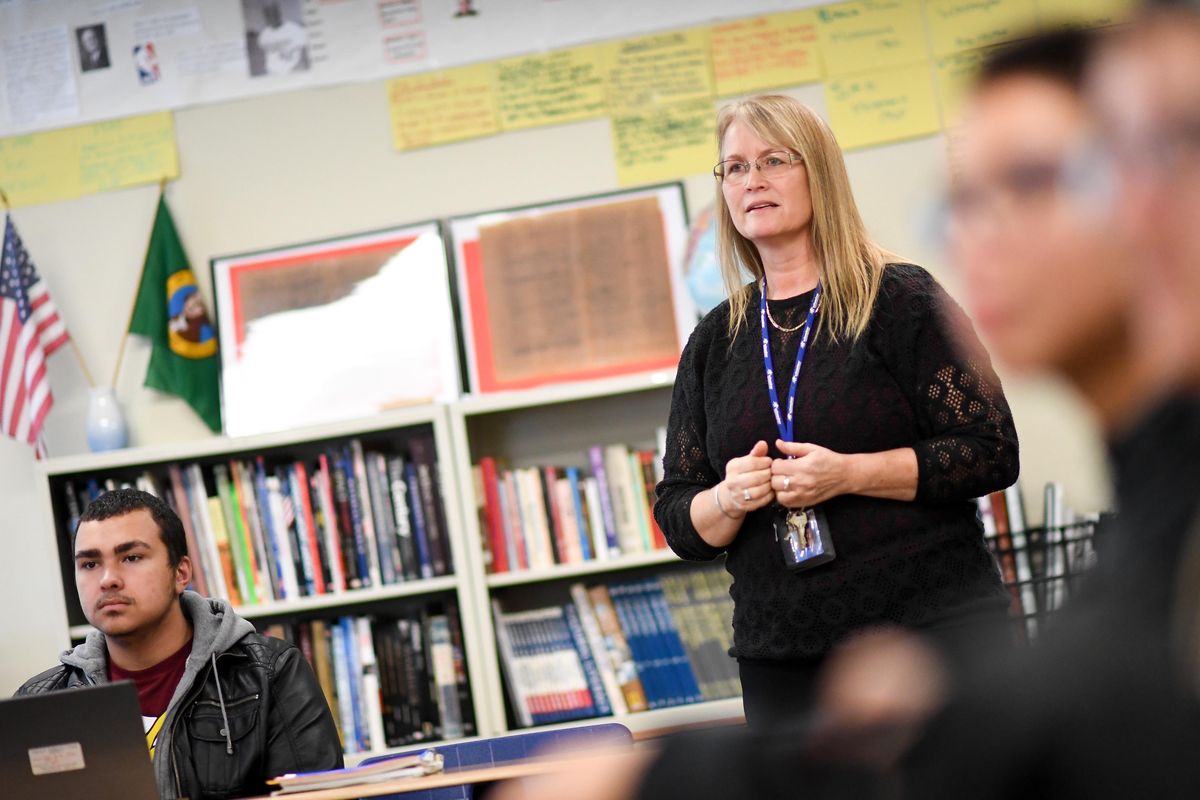With few choices and ‘a lot of unknowns,’ some rural school employees are wary of new health plans

WELLPINIT – Joni Scott teaches language, arts and history at Wellpinit High School and has done so for more than 30 years. She lives in the community, on the Spokane Indian Reservation, and in Stevens County.
When the School Employee Benefits Board rolled out new school employee insurance plans, Scott had five plans from two carriers to choose among, although she quickly realized her options were more limited than that. After making a phone call, there was only one plan offered that she could choose if she wanted to keep her same doctor in Spokane.
“Really, there was no choice,” Scott said.
State-sponsored health insurance benefits for school employees, which begin in January, are based on where each employee lives, not where they teach. This has been frustrating for some rural school employees, like Scott, who have significantly fewer plan options than their colleagues, including some who teach on the same hallway, who have more plan options due to their Spokane County home address.
In Wellpinit, teachers and school employees who are not members of a Native American tribe must seek care off the reservation. There are clinics south in Reardan and Davenport, or northeast in Springdale and Loon Lake. The nearest hospital is in Davenport or Chewelah, but Spokane is about an hour drive away. Nevertheless, the majority of school employees in the Wellpinit School District get their health care in Spokane.
Terry Bartolino, principal of re-engagement academies at Wellpinit, broke her wrist this fall on a Sunday and drove to the hospital in Davenport. However, her doctor, as well as any specialist she needs to see, is in Spokane.
“If you require any kind of special care or treatment you’re going to Spokane,” Bartolino said.
School employees had to do their research about which providers were in and out of network when choosing a SEBB plan. Rainy Anderson, the business manager at the Wellpinit School District, helped sign up about half of the school employees, who had either technical difficulties or could not get phone or Internet signal necessary to complete their sign-ups. Right before the SEBB registration deadline this month, several Wellpinit employees switched plans after finding out that Providence-affiliated providers were considered in-network for just one carrier offered.
“All of our membership has at least one doctor that they are going to see that’s in the Providence network, and it’s very rare that somebody is not,” said Shawn Brehm, the district music teacher and president of the Wellpinit Education Association.
When the SEBB board and the Health Care Authority created the program, they accounted for some rural school employees. School employees who live in counties that border Idaho or Oregon or work at a district that straddles county lines get access to a wider variety of plan options. For example, a school employee who lives in Stevens County but works in Nine Mile Falls School District has access to 13 SEBB plans, as opposed to the five plan options in just Stevens County alone.
These rule changes impacted 131 school districts, Dave Iseminger, director of the benefits division at the Health Care Authority, said. The Health Care Authority did a commuting analysis to see how rural school employees would be impacted by SEBB plans. Iseminger estimates that 20,000 employees live in one county and teach in a district that is at least partially in another county. By allowing border counties and dual-county district employees to access more plans, 5,000 rural school employees have more plan options. Further changes to SEBB plans are possible in 2021, however.
“It is certainly on our radar, and we plan to have discussions with carriers about opportunities to expand the work-based offerings as we prepare for the 2021 plan year,” Iseminger said.
Wellpinit school employees live not only in Stevens County but also in Lincoln, Whitman, Douglas and Spokane Counties, Anderson said, and due to limited rural health care options, Spokane is the central hub in the region for care.
“They don’t have the plans that everybody that lives in Spokane gets, but they have to go to Spokane to get their health care,” Anderson said. “How they have it set up is not fair, they all work for a state school, but we don’t get the same plans as everybody because of where they live.”
Both urban and rural school districts have to pay into the SEBB program, which concerns Anderson and administrators at Wellpinit. Under SEBB, Native American tribal members are not allowed to waive health coverage, despite being covered by the Indian Health Service, so they must pay for a health plan even if they will not use it. Anderson estimates that SEBB implementation will cost the district $250,000.
“When you only have 85 employees, a quarter of a million dollars is a lot,” she said.
The majority of Wellpinit school employees will also have to pay more for their plans under SEBB. Previously, Anderson could pool locally and keep premiums at no or low cost for employees. The majority of employees at Wellpinit chose a SEBB plan that costs $98 per month, in order to ensure access to Providence-affiliated providers.
Scott said she would not mind the price as much if she felt that the plan provided equivalent benefits in return. Instead of set co-pay costs for doctor visits, including specialist or urgent care visits, Scott will pay 15% under the plan she selected.
That percentage could equal out to a $20 to $30 co-pay, but the potential for additional charges for tests or care leaves “a lot of unknowns,” Scott said. “You’re going to go to the big city for your medical care and this plan doesn’t account for any of that.”